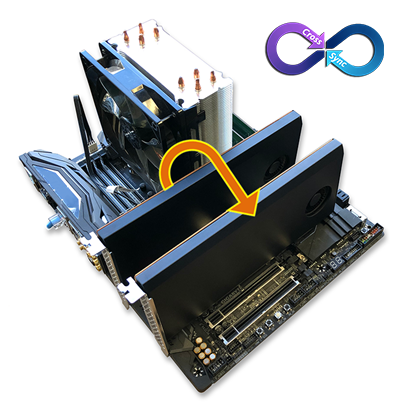Need More than 14,000MB/s?
- Tutorial Videos & Installation Guides
-
FAQ
FnL Product Line Determining PCIe lane assignment for your SSD7000 Controller MacOS Windows Linux SSD6200 Series Controller SSD7000 Series Controller RocketStor Series RocketRAID Series RocketU Series Motherboard Compatible Report Other Questions Standard Responses for Known Issues or Subjects WebGUI eStore Gen5
- HPT
- Compatibility Reports
- FAQ
- Workaround Issue
HighPoint's Cross-Sync Technology delivers Gen4 performance in a Gen3 package!
HighPoint’s Cross-Sync NVMe RAID Technology can be seamlessly integrated into today’s fastest PCIe 3.0 workstation and server platforms, which are capable of providing up to 128 lanes of transfer bandwidth. This potent combination is ideal for I/O intensive applications such as video editing and production and 3D animation, redering and design. 
Editing raw Ultra-HD 8K video footage requires sustained transfer performance in excess of 17,900 MB/s; numbers that are simply unobtainable for standard PCIe Gen3 computing platform. Todays fastest PCIe 3.0 x16 RAID controllers can hit 14K MB/s - close, but still no dice.
However, add HighPoint's Cross-Sync into the equation…
Suddenly, everything changes.
Cross-Sync technology allows customers to easily link two SSD7000 series 4-Port M.2 NVMe RAID controllers, or a pair of SSD6540 RAID Enclosures to function as a single storage device; essentailly doubling your performance and capacity thresholds!
A dual-card Cross-Synced SSD7105 configuration can host up to 64TB of storage and deliver up to 28,000 MB/s of transfer performance – exactly what you would expect from today’s fastest 8-port PCIe Gen4 controllers!

HighPoint's Cross-Sync NVMe RAID Technology enables administrators to easily configure RAID arrays using NVMe SSDs hosted by multiple SSD7000 series NVMe RAID controller cards.
Provided the hardware requirements have been met, Administrators can configure a Cross-Synced RAID 0 or 10 array using the standard versions of the CLI (command line interface) or WebGUI management software.
The screenshot on the left shows two SSD7101A-1 controllers hosting a mix of 1TB and 512GB Samsung 970PRO SSDs.
In this example, the WebGUI has automatically generated a list of all avaiable NVMe SSDs. The E1 and E2 labels under the Location column refer to Controllers 1 a nd 2 respectfully.
The process is seamless and entirely transparent to the host system. A Windows or Linux OS will recognize a Cross-Synced RAID configuration as an ordinary "drive".
Unbeatable Storage Performance


Hardware Requirements
In order to maximize the performance of a Cross-Sync solution, you will need a motherboard/comptuing platform with two free PCIe 3.0 slots, each with x16 or x8 eletrical lanes, depending on your selection of RAID controller/enclosure.
Cross-Sync Capable PCIe Gen3 M.2 NVMe RAID Solutions:
SSD7105 - 4x M.2 PCIe 3.0 x16 Bootable RAID Controller
SSD7104F / SSD7104 / SSD7101A-1 - 4x M.2 PCIe 3.0 x16 RAID Controllers
SSD7202 - 2x M.2 PCIe 3.0 RAID Controller
SSD7204 - 4x M.2 PCIe 3.0 x8 RAID Controller
SSD6540M - 4-Bay PCIe 3.0 x16 RAID Enclosure